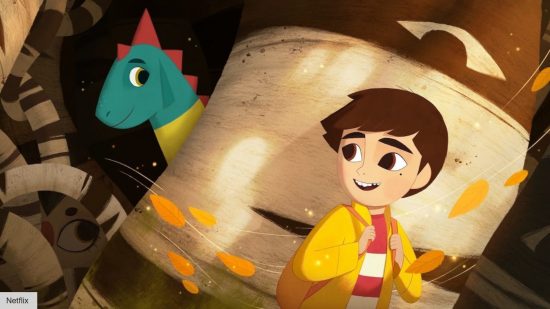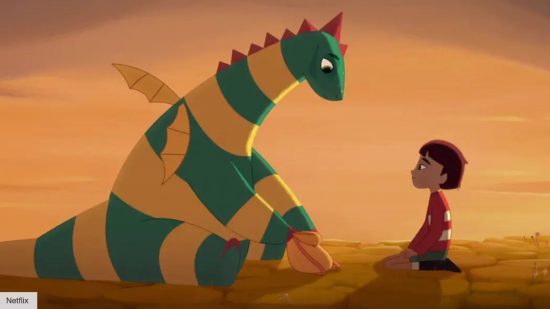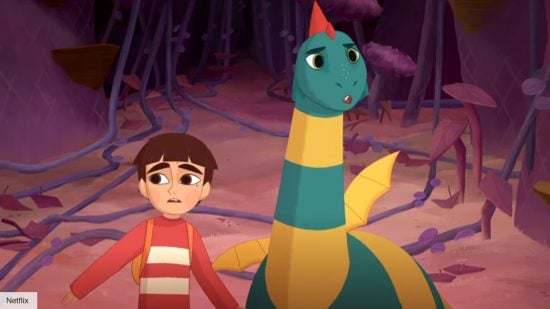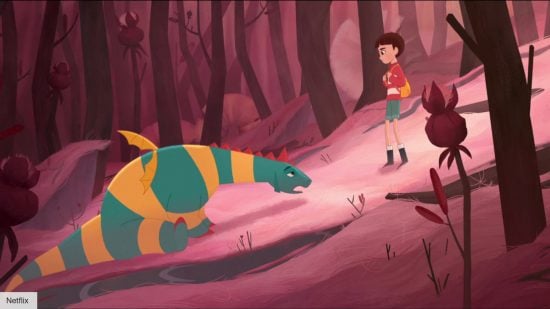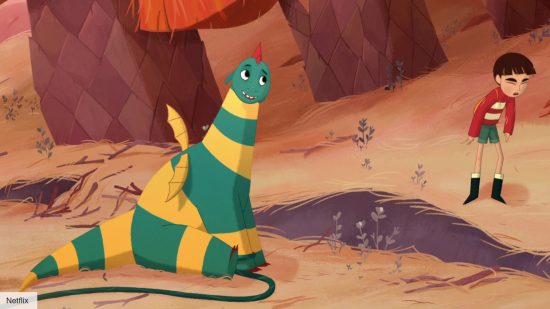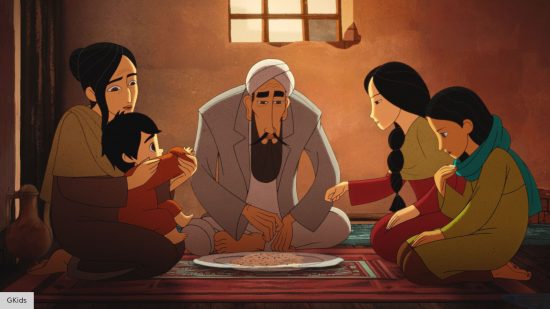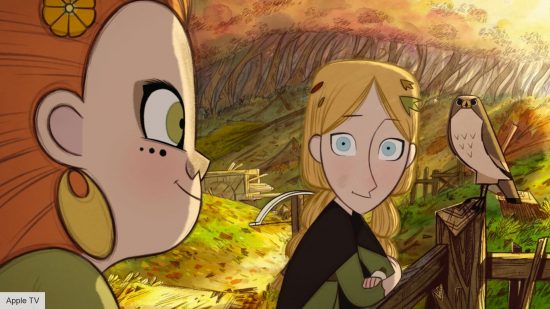A new animated movie from Cartoon Saloon is always a remarkable thing. My Father’s Dragon, released in 2022, marked a changed for the studio. Instead of getting a wide release, the Netflix movie had a brief period in cinemas before heading to the service.
Giovanna Ferarri, a storyboard artist and supervisor at Cartoon Saloon, gave The Digital Fix some of her time to talk about the fantasy movie on the back of the RENDR Festival. Following a young boy, Elmer, who goes on a magical journey to a strange island where he meets a dragon in training, named Boris.
Their journey through-out the adventure movie draws on many of the qualities Cartoon Saloon has become known for, merging human drama and mythical world-building. Ferarri walks us through all of that, why The Breadwinner matters so much to her, and the incredible inspiration behind Wolfwalkers.
The Digital Fix: How has the reception been to My Father’s Dragon, do you think?
Giovanna Ferarri: I think that the children loved it, because it’s refreshing for them to see a story that was really aimed to them. We were worried about how fans of the book would respond to it, and we think that it’s been liked to them from them, so we’re happy about that.
All in all, I think we’re happy about the reception, even though obviously, it’s sad that we didn’t get the Oscar nomination this time. But I think that it’s part of a bigger Netflix situation. I don’t know what happened there.
But we’re happy about about how it went. It was very, very hard to push through that production during the pandemic. With all the cuts to show that have been going on, we’ve been incredibly lucky to be supported by Netflix throughout the whole movie.
We’re very happy, they really helped us, we wouldn’t have made it without them supporting us. I mean, if it hadn’t been a Netflix movie, I don’t know how we would have handled the pandemic, disrupting it so much.
So Netflix were supportive from the jump? How did that relationship impact production? Was there ever talk of delays to production?
They had a very precise slate for the movie release. And we actually, I think we delayed it for a little bit because of the pandemic, but they were there from the beginning. They were the owners of the movie from the start, basically. So it’s a bit of a new thing for Cartoon Saloon.
Even when Wolfwalkers got bought by Apple afterwards, it was made completely alone, in co-production. Cartoon Saloon is much more used to that kind of co-production model in which you have very little money, maybe, but you’re completely independent. With Netflix, it was different. They were the owners of the movie from the start.
Therefore, we were for the first time confronted with a different way of making movies, it took us a while to get used to, it wasn’t super easy. But really, the pandemic, once we had to basically just move home all of us, we needed a lot of support for that, and we got it from Netflix. We wouldn’t have had the same availability of money or possible solutions if Netflix wasn’t there from the start.

My Father’s Dragon feels like a culmination of Cartoon Saloon thus far, somewhere between the Breadwinner and Wolfwalkers. Would you agree with that reading?
Yeah, I hope so. As filmmakers, Cartoon Saloon is evolving constantly, we never stop. We learn from previous movies and push forward. Obviously, Nora, being the director of The Breadwinner, and the director of My Father’s Dragon, there’s a lot of her in both movies. But in Cartoon Saloon, we really work together all the time.
All the filmmakers are always involved in all the movies we make. There’s a constant flow of ideas and of personality. We are incredibly in influenced by other movies we do, because the people are the same, more or less at work on every production. So we just improve, I hope so.
One of the most remarkable parts of My Father’s dragon is the way it changes, from set-piece to set-piece. It starts as a drama, then moves into fantasy, can you talk about putting together the transitions and flow of the film?
We were inspired by the core idea that everything that happens, it’s actually inside his head. So every character he meets on the island, the island itself, everything is just his descent into his own subconscious. So it’s him diving to the root of his fears, and to the root of the problem.
That really helped us making the transitions move in the sense that you can play a game and try to take every character that is on the island, every moment that he meets on the island, every thing that happens on the island, you can trace it back to his life and to the characters he meets in real life. You can find that there is a correspondence between those two worlds at every moment. That really was our way of thinking.
Wild Island is a remarkable backdrop, can you describe working out the geography of the location?
The island was a character itself. To be honest, it was really hard. It was the first time for me, at least, where I found myself having to imagine a movie in which the backgrounds and the location arer a character so much. It was very challenging. For the geography, the most important thing for us was to think about screen direction, the fact that we wanted an Elmer and Boris always to move from left to right, mainly to have this idea of going and not coming back, until eventually they do come back.
We really needed to feel that the animals were part of the island in a very organic way. So much so that they actually blend in, most of them. So, every encounter has a blending feature; the crocodiles, they are blended in the water; the tigers, they are camouflage; and the rhino is hidden in the pit. They are all hidden inside the location, and it comes back to the fact that both the island and the animals are different symbols for different states of fear and different reactions.
It was interesting as well, when the island shakes at certain moments that kind of look like they are random, but they aren’t. In our head, they were linked to moments which Elmer had doubts, when Elmer actually was scared or had moments of re-balancing of his own mind. That was what guided us to have the shakes of the island.
They very organically connected the story and the character. So it was never disconnected. We talked a lot about how the summit was at the end, that we saw it four times, how the place changes. And it was very difficult to have a change, but still look similar enough that you could actually recognise it when you come back to it. So there were a lot of these challenges.
There’s a stunning song sequence in the family movie, and the transition is sudden but it flows incredibly well. Was this always part of the story? How did you construct that scene?
Yeah, it was from very, very early on. Nora knew that she wanted to remind the audience of the real stuff at stake here. That sequence happens after after Boris reveals his secret, right? He says, ‘Deep down, I hope I was happy, that this didn’t happen. I don’t have responsibilities. I can stay the way I am, and I can keep living this way’. He tells Elmer, ‘I’m so in awe of you because you’re never afraid’.
Then Elmer has this chance of actually telling him the truth, and if he did, you know that things would really change there. If he told him yes, I’m always afraid as well, then you will be at the end of the movie, basically. That was his chance to fix things in a way that would have worked much better for everybody.
But he doesn’t, because he’s not ready yet to actually say that he hasn’t faced the loss, and the real realisation yet. So it was important there to actually give a hint of the fact that no, actually there’s something deeper than that, and see his humanity and remind us that, ‘Oh yeah, this kid, the argument with mom, the fear about the uprooting, he’s this kid who’s lost’.
We could show that he’s really afraid without actually saying it. That was the leading idea. For how to we did it graphically and how we made it in a seamless way, that wasn’t difficult at all in a way. It was funny to make because Nora briefed the idea that she had, and I made a really rough pass or sketch of the whole thing. Really, really roughly on Toon Boom, and a bit of TVPaint for some more animated bits.
Then we edited exactly as she wanted, she changed a bit, and then we split it in four. We had four animators working on it mainly, and there were some supervisors as well, we really chipped in, it was almost a little short that we did as one of the last things in the movie. It was very organic, because it was all it was really stemmed from Nora’s imagination.
My Father’s Dragon is based on a book, how did that figure into your process? Were you trying to be true to the text, or was it more of an inspiration?
More of an inspiration because the book is wonderful, but it’s a bit of a period piece and we meet the dragon at the very end. So we would have missed this relationship. Very early on, Nora really understood that the most interesting thing for a movie, not for book necessarily, but for a movie was to see this relationship grow, and to see these two kids interacting and growing together.
That’s the biggest difference I’d say. What Nora did is that she she was in a lot of contact with the with Ruth Stiles Gannett, that is the author of the book. She drew a lot of inspiration from her life and from her house, and from herself as a person too. It’s an inspiration from a book, but also from an author. Amazing person.
The Breadwinner is one of my favourite films of the last decade, and I was struck by how different it is. It’s more of a drama movie rather than being fantasy, can you speak to working on something like that?
I relocated into Ireland to work on that movie from France, I relocated my child to work on that movie. That’s how important it felt for me, that story. I think that when you have the chance as a storyteller as a director or as a storyboard artist, or whatever, to actually help the storytelling of a story that is needed, that is really needed. Well you cannot say no, it’s just the biggest chance you can have in life really. It happens sometimes once in your lifetime, and you’ve got to take it because it’s very rare.
That movie was one of the most incredible experiences I’ve ever went through. I would redo it tomorrow if I could. Just amazing. It was very difficult to work on that movie, because there was a sense of we were walking on eggshells all the time, we needed to be incredibly respectful of everything. I think, as a storyteller, that’s really where I learned a lot, in terms of being very careful to watch the perception of what you say.
So you can say a thing, and that can be understood in a different way. With the Breadwinner, we couldn’t risk being misinterpreted, or being misconstrued. We couldn’t risk it, we needed to be super careful with that. We had to be very respectful of the location, this was a place we didn’t know and we couldn’t go to.

It’s in the past, that Kabul doesn’t exist anymore. And also the people, what they were going through, it was really hard to imagine. But one thing we did remember, we had a burqa at work, and everybody who was working on the movie had to wear it for a while to understand and feel it.
We had a lot of help from consultants from Afghanistan, people who went through that period, who could really help us not only nailing down details, but also stupid questions like, ‘How do people stand? How do they walk?’ You know, it’s a different culture, it’s a different situation, people do not necessarily walk the same or act the same way you would imagine. So, it was the furthest things possible from the classical Disney tropes that they teach you are cool, you know, ‘You’re gonna have a take and then, the reaction and then…’, an arc like this.
No, that had to be out of the window. It was really about how does this human behave in the situation. Nora is an amazing director, but she’s also an amazing actor, she’s incredibly good at acting. She helped not only the animators, but also everybody who worked on the movie by making videos in which she would actually act out the parts, with the help of some people.
We wouldn’t rotoscope at all, but we would have an idea of how people moved so we could know, when you turn, you actually turn this way. So we would be as far as possible, from Western animation tropes.
There was a lot of asking to other people outside the studio, and there was a lot of asking ourselves questions, asking Google questions. I remember spending incredible amount of time trying to figure out, how do you recharge a Kalashnikov? And then finding out that actually are two ways of recharging a Kalashnikov, the American Way and the Russian way. There I thought, OK, the Taliban must have learned it from the Russians, therefore, they you have to do it this way. So it was all the incredible amount of questions.
I attended the premiere at Dublin International Film Festival, and there was some emotional feedback during the Q’n’A section. People seemed to really respond to the picture. How was the reception as you toured it around?
Yes, Nora tells us that yeah, it was amazing the reception, especially in Afghanistan, and especially among Afghan communities. It breaks my heart to think that how the situation is now. In a way when the Breadwinner came out, the situation in Afghanistan was so much better now. When the Taliban came back to Afghanistan, it really broke my heart. and it’s very hard to imagine how, how Afghanistan people will watch it now.
At the time when it came out, yeah, we got an incredible amount of support, but also really of understanding, and new connections. I think Nora did a great job and really managed to navigate a very, very difficult movie in a very good way. I don’t know how she pulled it off, but she’s amazing.
You’ve worked under Tomm Moore and Nora Twomey. How would you say they compare to each other as directors?
They’re very different. They’re incredibly different. I really like the fact that they complete each other in a lot of ways. Nora has a very cinematographical approach. She runs an animation movie almost as if it was a live-action movie. You can see it in the editing, the shots she chooses, you could literally have the movie in live-action. It’s really impressive.
She obviously uses animation for a purpose, and it enhances the story and she it allows us to tell a story that would be very hard to tell otherwise, but she really has a camera in her hands too, in a way.
Meanwhile, Tomm has a much more illustrative attitude. His approach to for as a storyboard or for instance, his approach to scenes is, ‘I have this image in my head’, we go to land in this shot, and this shot is like an illustration that is very symbolic. Or maybe it’s a shot that will stay on the screen for a long time. It’s a completely different way of storyboarding, it’s a completely different way of working.
He tries a lot of stuff, and he draws a lot of images and it’s much more of an illustration, a painting experience, rather than with Nora. They’re very, very different, but they complement each other very wonderfully so that Tomm will always help Nora out with her movies and the other way around. They flow in beautifully.
You worked on Wolfwalkers as well, which feels particularly special for Cartoon Saloon as the end of the Celtic trilogy. Did making that film feel as magic to make as it does to watch?
When we worked on Wolfwalkers, the incredible thing about it was that, if you think about Wild Island that is a place that doesn’t exist that is totally alien or you have to completely invent from scratch, with Wolfwalkers, the location is Kilkenny, and we live in Kilkenny, and there are the forests around Kilkenny.
The incredible thing about that was because we started, all our story team, by going for a beautiful day out in a beautiful location here nearby in the forest, where there is a waterfall, and it’s one that’s really magical. It really looks like the forest where Maeve and Robin hang out.

We spent the entire day, just doodling, eating, and chatting. We were exploring, and it was just us, because the place is actually private, and they gave us the keys, and it was awesome. That was really the beginning, and that was really where we felt, ‘Yeah. OK, this is what we have to do. This is the place this is the feeling this is the sound’.
I don’t know if you ever walked through this part of Ireland, but it’s magical. The immersion in nature in this area brings that up, inevitably. So the fact that we were all working here, we were all working in the same place, we were together, we were surrounded by that really helped and really made you feel it all. I think magic was there from the beginning because it’s here.
Amazing, the Celtic trilogy has always pulled on my heartstrings, the way it merged Irish fantasy and history and nature and encapsulated them so well.
Tomm Moore and Ross Stewart, the directors of Wolfwalkers, they are both really, really into nature and preservation and animal rights and ecology. That’s really something that you can feel here, the struggle between the farming, the industrial side that is eating at the nature, and the nature that is as large as you can imagine it when it’s left to be wild, and then you have this destruction of it. So that that was really at the core as well of the story.
Cartoon Saloon has done incredible things in 2D animation. Are there any plans to ever move towards 3D and try that kind of animation?
There’s no plan that I know of. Cartoon Saloon took a gamble back in the days of resisting this wave of 3D and new technology, CGI. Focusing on the idea that storytelling is storytelling, and that you should do the things you know how to do best and just keep to them. You don’t need to learn something new if you know how to do something. You use the medium that serves your story. Every story has been absolutely true to the story, as in that was the best way to do it.
We do use technology in a very subtle way, to paint we use some some tools, there are simplification of 2D sometimes, but they’re just helping the process. I think that you should do what you do best. To be honest, 2D drawing will stand the test of time, like it’s something that will always look good. It doesn’t decay with time.
Everything that comes from new technologies is old after a couple of years. It’s a matter of sustainability in the long term as well. You know, it’s an indie that does movies that hopefully will be watched forever. I guess for a big company that can shoot out a movie every year, it doesn’t really matter if nobody will watch it in two years. For us, it’s a bit of a different story. We’re not a consumeristic, we really are not a consumeristic studio.
What do you hope people take away from My Father’s Dragon?
It really is a movie about fear, and in a world that is so shaky, like the island, I hope that kids really take away this feeling that you just need to reach out and be in contact with the rest of the people around you. Make friends and rely upon each other and give each other support and empathy. That’s really the only way out of the certain crisis.
You can’t go back to what it was before. That’s the thing. We really made a point about My Father’s Dragon that Elmer doesn’t get what he wants, he doesn’t fix anything. You don’t fix things sometimes, you know. But you can go through it and you can grow and make friends and enjoy things, even though not everything is in your power to fix and you got to control it.
You can expand your inner self to other people and be good with that and be happy and have a happy life. In a moment that is so scary for a lot of young people, and not only young people, it’s so uncertain and shaky. That’s really a very important message that I hope they bring home.
Giovanni Ferrari is speaking at the RENDR Festival, running February 23 and 24. You can find out more on the official site. Check out our best animated series and best anime movies lists for more great viewing options, and our new movies guide.
